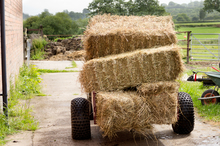For horses that have respiratory issues, soaking hay will reduce the amount of respirable dust concentration that the horse takes in. The longer the hay soaks, the more the dust concentration is reduced. The RDC numbers begin to climb if the hay is allowed to dry before feeding, so feeding the hay while it is still wet is important.

Hay for horses
Soaking hay for short durations of 15 to 60 minutes is an acceptable management method when it is necessary to feed your horse soaked hay.
For horses that have respiratory issues, it is also important to keep the entire environment dust free, especially during feeding times. This means no mucking during meals and keeping the stalls, fans, and rafters dusted, as well as using special bedding.
For horses that have metabolic issues such as insulin resistance, soaking horse's hay can reduce the water soluble carbs. Research shows that the longer the hay is soaked, the more the WSC content is reduced.
Veterinarians sometimes prescribe soaked hay following a colic episode or when a horse becomes dehydrated. For these circumstances, the wetter is better, so it is important to monitor the soaking process. According to research approximately 30 minutes is sufficient with most hay.
Research shows that owners should rely on forage analysis, both before and after soaking, as the primary method of determining the appropriate hay for horses, especially when feeding horses diagnosed with laminitis, PSSM, HYPP or COPD. For these horses, analysis of the NSC, P and mold content for horses with COPD of the forage is key.
Hay soaking for short durations (15 to 60 minutes in duration) is an acceptable management method, but should only be used if preferred hay is not available. Soaking hay for longer durations (i.e. 12 hours) resulted in very low NSC content, high calcium to phosphorus ratios, shortage of phosphorus in the diet, and high dry matter losses
The study found that soaked hay should be fed immediately to reduce the chance of mold.
The researchers also cautioned horse owners that care should be used when disposing of water used in soaking hay. Water should be disposed of in random grassy areas and should not be accessible to horses because of the high carbohydrate and nutrient content.
Best techniques for soaking hay
Usually no special equipment is necessary to soak hay for your horses. A muck tub, a big bucket, or a small wheelbarrow will work well. You will need to be able to drain the water from the hay and it works best to fill your container near the drain, so there is no lugging of heavy hay and water concoctions across the barnyard.
Smaller tubs work well, also. Stuffing a hay net with hay, then soaking it in the net lets you remove the hay without much effort.
To make draining and clean up easier, make sure your drain is covered with some sort of mesh catch device.
If you feed your soaked hay directly on the ground, clean any left-over hay up to prevent it from spoiling and creating an unsanitary mess. Using a mat under the pile of damp hay works well and makes any cleanup easy.
